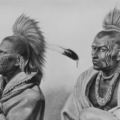The Public “I” of Julie Otsuka

Few writers of color in the twenty-first century work in the fierce tones of the Black Arts and Red Power movements. Few writers of any race, working in any genre, are creating truly radical experiments in form or process or argument. This is not to say, however, that contemporary fiction is lifeless or conservative. A certain urgency remains, if not in the booming political voices of the 1960s, then at least in the wry passions of older writers such as John Berger and Eduardo Galeano, as well as in the cleverly submerged politics of younger writers such as Colson Whitehead. To be sure, some women and people of color are producing more confrontational political fiction than these, but their work is seldom as formally experimental. And perhaps it is true that the most conspicuous mergings of politics and formal experimentation occur today in poetry and drama, where, for example, Craig Santos Perez and Young Jean Lee both dazzle and disrupt.
Then there is Japanese American author Julie Otsuka. Otsuka has published only two short novels, When the Emperor Was Divine and The Buddha in the Attic, the latter of which was both a 2012 PEN/Faulkner Award winner as well as a New York Times best-seller. Both books are accessible and popular enough to be adopted by book clubs and reading groups, and both were reviewed widely. Old radicals might understandably suspect that Otsuka has sold out to the literary marketplace. Sifting through the many reviews, profiles, interviews, and book club discussions, they would be unlikely to find evidence of any radical politics or brash experimentation. They might conclude that Otsuka, for all her literary ambitions, is a “safe” middle-of-the-road novelist. But looks are deceiving.
When the Emperor Was Divine tells the story of a Japanese American family before, during, and after the second world war, in which the central event is the family’s wartime evacuation from their home for years of imprisonment in a desert concentration camp. This is not, however, another predictable “internment novel” of the sort with which Japanese American readers are all too familiar. For the plethora of details that give the story a sense of trustworthy realism, Otsuka takes two major, if subdued, risks. The first is her choice to leave the characters—parents and their two children—unnamed. In a work of fiction that were not so rooted in history, this might not be notable. But in a novel written by an author of color that is based on a history of subjugation, specificity is one of the first and most formidable rules.
Otsuka’s refusal to name her characters does not transform them into symbols or stereotypes of their community, though—they are vividly drawn and individuated by the events of her book. But this choice does enable Otsuka’s second quiet experiment: the brief closing chapter, which is told in the voice of the father who, having been taken by the FBI long before the rest of the family’s evacuation, has been separated from them for years in a prison for men suspected of collusion with the Japanese enemy. In an interior monologue of less than four and a half pages, this man, broken and bitter, “confesses” to the racial stereotypes of Japanese Americans and abjectly apologizes for his racial guilt. It is a pathetic performance that demonstrates the extent to which racism and state-sponsored violence have stripped him of his identity, made all the more stark when set against the vividness yet namelessness of all the characters. James Baldwin, who believed that writers of color are obligated to feel rage over the history of their people’s oppression, would surely be impressed by this bitter, desperate chapter.
Otsuka’s second novel, The Buddha in the Attic, evolves the risks taken in her first book. Here the characters are nameless again, but this narrative is written entirely in the plural voices of communities. As with other writers who have adopted this point of view, the author is challenged to find ways of insisting on the particulars of her characters’ lives, details true to Japanese American history. This hazards clumsiness in the swerving from one locus to another within the group, as when the women settle into the boat that is taking them to the United States:
Some of us on the boat were from Kyoto, and were delicate and fair, and had lived our entire lives in darkened rooms at the back of the house. Some of us were from Nara, and prayed to our ancestors three times a day, and swore we could still hear the temple bells ringing. Some of us were farmers’ daughters from Yamaguchi with thick wrists and broad shoulders who had never gone to bed after nine. Some of us were from a small mountain hamlet in Yamanashi and had only recently seen our first train. Some of us were from Tokyo, and had seen everything, and spoke beautiful Japanese, and did not mix much with any of the others. Many more of us were from Kagoshima and spoke in a thick southern dialect that those of us from Tokyo pretended we could not understand. Some of us were from Hokkaido, where it was snowy and cold, and would dream of that white landscape for years. Some of us were from Hiroshima, which would later explode, and were lucky to be on the boat at all though of course we did not then know it. The youngest of us was twelve, and from the eastern shore of Lake Biwa, and had not yet begun to bleed. My parents married me off for the betrothal money. The oldest of us was thirty-seven, and from Niigata, and had spent her entire life taking care of her invalid father, whose recent death made her both happy and sad.
This narrative roving among the women assumes a rhythmic flow that gathers even as it particularizes. In works of fiction that draw upon a people’s history, the sweep of the narrative must account for both particles and waves.
History calls these women “picture brides.” For most, economic hardships prompted their families to send them to the United States to marry immigrant Japanese men. In many cases, they left Japan married to the men in absentia. In the decade between 1910 and 1920, an estimated 9,500 women migrated from Japan to the United States as picture brides. They often arrived to find that some of the men were old, and had been abroad for many years; they had lured the women with photographs taken in their youth, when their prospects looked brighter, and with promises of good fortune. For their part, Otsuka’s women are hopeful: “On the boat the first thing we did—before deciding who we liked and didn’t like, before telling each other which one of the islands we were from, and why we were leaving, before even bothering to learn each other’s names—was compare photographs of our husbands.” But they are neither simple nor naïve:
Perhaps the real reason we were sailing to America was to track down a long-lost father who had left the family years before. He went to Wyoming to work in the coal mines and we never heard from him again. Or perhaps we were leaving behind a young daughter who had been born to a man whose face we could now barely recall—a traveling storyteller who had spent a week in the village, or a wandering Buddhist priest who had stopped by the house late one night on his way to Mt. Fuji.
For most of the women, the horrors in their lives are yet to come; some of them sense this, even if they cannot articulate it.
A few other novels and at least one feature film tell stories of individual picture brides. These portrayals show the hardships the women faced: adjustment to life in a strange new home, disappointment in marriage, estrangement from assimilating children, invisibility in thankless and low-paying labor, racism and sexism. Novelists and filmmakers have struggled to make their individual protagonists typical of a community—that is, to raise individual stories above the level of anecdote. They struggle against the inverse relations of history and fiction: the more compelling they make their protagonists’ stories, the less those characters appear rooted in history. Otsuka solves this inversion by creating a communal protagonist. If the story of one picture bride can be the story of all picture brides, Otsuka shows that the reverse is also true, and therein lies the genius of her experiment.
The Buddha in the Attic, though it spans a longer time than its predecessor, is an even shorter volume. Sustaining a plural voice is difficult, even for a novelist as talented as Otsuka. And at the end of this book—just as in When the Emperor Was Divine—Otsuka launches into a variation on her narrative experiment. The closing chapter of The Buddha in the Attic remains in the first-person plural voice, but the voice now belongs to the white residents of the towns and villages into which the picture brides had settled. Just as significantly, this plural voice loses its gender, and suggests powerfully that gender matters more to those who are racially oppressed. Until this closing chapter, the book has demonstrated what we might call a triple consciousness: not only the racial dichotomy that W.E.B. Du Bois described but also the additional dimension of gender. By writing in a pluralized first-person perspective, Otsuka is able to inhabit all three levels of consciousness. The shift in the closing chapter is thus particularly jarring.
But The Buddha in the Attic is also a story of erasure. The mix of despair and hope that drives these young women away from Japan drops them into a place of instability and uncertainty. They still have a voice, though, even if the superior Tokyo women are nostalgic for what they left behind. They are all fearful of what lies ahead. None of the women have much cultural or economic capital when they arrive, so they settle into lives that are full of drudgery—the neglect or abuse of their immigrant husbands, the racism and sexism of their white towns and villages, the poverty and toil of their labors—and endure them quietly. As they age, they lose some of their autonomy. They wither and shrink. Racism, sexism, and labor begin to erase them. Their evacuation and imprisonment in 1942 merely expedites this erasure. The last chapter, spoken in the plural voices of their white neighbors, at first startles us with its abrupt and unexpected change in perspective—but it is the natural and obvious progression of the women’s erasure. Their voices are dispossessed when their bodies are. The opening sentence of the last chapter, the first words spoken by white Americans, says, “The Japanese have disappeared from our town.”
Otsuka’s penultimate chapter is titled “Last Day,” and it narrates the story of the women leaving their homes for the camps. It is a single ten-page paragraph, in which the women observe each other as they prepare for another long journey, this one more frightening than the first. Otsuka builds the chapter around a litany of repeated constructions:
There was an old man from Gilroy who left on a stretcher. There was another old man—Natsuko’s husband, a retired barber in Florin—who left on crutches with an American Legion cap pulled down low over his head…. There was a newborn baby from San Leandro who left sleepily, with her eyes half closed, in a swaying wicker basket…. There was a boy in short pants from Oxnard who left wondering whether or not they’d have swings…. There was a woman of uncommon beauty whom none of us had ever seen who left blinking and confused…. There was a national fly-casting champion from Pismo Beach who left carrying his favorite bamboo fishing pole and a book of poems by Robert Frost.
Young writers learn in creative writing classes to avoid “there was” constructions, which seem to be desperate fillers, but here Otsuka uses them both transitionally, with “there” serving as a deictic pointer, and geographically, with “there” fixing her characters in a space they will soon be forced to abandon. Hope brightened the uncertainty the women might have felt when they journeyed to America, but now hope has been drained. Their departure is sloppy, haphazard: “Iyo left with an alarm clock ringing from somewhere deep inside her suitcase but did not stop to turn it off.”
The whites who speak collectively in the closing chapter are not obviously bigots, and their narrative is made up mostly of observation. “All we know is that the Japanese are out there somewhere,” the last sentence reads, “in one place or another, and we shall probably not meet them again in this world.” Of course, Japanese Americans did return after the war; and while some relocated to new homes in the Midwest, most returned to the West Coast. For the women who narrate most of the book, there is no third uprooting, only a return. We do not know whether, like the husband and father who narrates the closing chapter of When the Emperor Was Divine, they will become bitter and desperate and lifeless. Otsuka spares us that prospect.
In a short story that appeared in Granta at about the same time as The Buddha in the Attic, called “Diem Perdidi,” this quiet experimentation was set in more conspicuously personal terms. Otsuka says, in the 2012 version of The Best American Short Stories, that the story is drawn from observations made of her mother’s decline; it is “the most personal and the emotionally ‘truest’ (though fictional) story I have written.” The story’s opening is both chilling and reassuring:
She remembers her name. She remembers the name of the president. She remembers the name of the president’s dog. She remembers what city she lives in. And on which street. And in which house. The one with the big olive tree where the road takes a turn. She remembers what year it is. She remembers the season.
A few pages later, the closing paragraph retains some of that reassurance, but now its opening sentences hold a growing burden of loss:
When you ask her your name, she does not remember what it is. Ask your father. He’ll know. She does not remember the name of the president. She does not remember the name of the president’s dog. She does not remember the season. She does not remember the day or the year. She remembers the little house on San Luis Avenue that she first lived in with your father. She remembers her mother leaning over the bed she once shared with her brother and kissing the two of them good night. She remembers that as soon as the first girl was born, she knew that something was wrong. She didn’t cry. She remembers holding the baby in her arms and watching her go to sleep for the first and last time in her life. She remembers that they never buried her. She remembers that they did not give her a name.
In the closing sentence, the woman bursts into remembrance of the day, though not of the year: “She remembers that today is Sunday, and it is time to go for her ride, and so she picks up her purse and puts on her lipstick and goes out to wait for your father in the car.” In this story, as in the two novels, literary style and experiment carry within them the knowledge of history.
People of color must reconstruct their histories as best they can, often through the sloppy, patchwork stories of elders, which gather inefficiently into a collective consciousness. In what Du Bois might have called their first consciousness, the home consciousness of their communities, people of color cling to these stories and pass them on to their children. When these pass on to the oppressor, through that second consciousness that engages the dominant power, the meaning and value of those stories risk becoming lost. Only the rare writer of color is able to connect history with all three forms of consciousness without losing that value; Julie Otsuka is such a writer. White writers are often praised for the universality of their themes and characterizations, but that universality is merely a default position for writers in the dominant culture. For writers of color, reaching for universality risks the same type of erasure as assimilation, losing the particularities of the home culture, that first consciousness. To overcome that risk is to achieve the boldest experiment available to the writer in an unequal world.
About John Streamas
John Streamas is an associate professor of American Studies and Critical Culture, Gender, and Race Studies at Washington State University. His scholarly and personal interest is the cultural politics of time and space.




